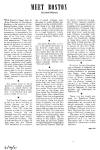
Home Page Meet Boston Menu Index
|
MEET BOSTON Friday, February 14, 1941 in What's New In Town W. J. Sidis |
The Franklin Street side of the Chamber of Commerce Building is the location of the Massachusetts state convention which ratified the present Federal Constitution. This convention is remarkable for the long debate and the close split of its final vote, which made it necessary to ratify with reservations. There was so much objection to centralization of powers, to possibilities of dictatorship, and to other points discussed in detail, that a compromise had finally to be struck―Massachusetts ratified, on [Wednesday] February 6, 1788, with the reservation that amendments must immediately be proposed guaranteeing individual civil rights. So many other states followed the lead of this Massachusetts convention, that the amendments had to be put through the “Massachusetts reservations,” conceived on Franklin Street, became America’s Bill of Rights.
*
The largest bank in South America―located in Buenos Aires―is called Banco de Boston (meaning Bank of Boston). It is a branch of a well-known bank of this city.
*
The Fine Arts Museum used to be in a brick building in Copley Square, on the St. James Avenue side of the square. After 1905, when the museum moved to its present Fenway location, the old building was only used occasionally, when some exhibition hired the building. One of the best-known of these (at that time) was the “Boston 1915” exhibition, by a committee of social workers who planned to make Boston the finest city in the world by 1915. (We think it is, and always was). Later, the old arts-museum building was bought up by a hotel company, which wrecked the old museum and put up the Copley Plaza in its place.
*
The Great Blue Hill, in Milton, is the highest elevation on the Atlantic coast south of Maine. It was called Masadchu―Great Hill―by the Indians who lived hereabouts, and their country was the Great Hill Country―Masadchuset. This is still the name of the region―slightly altered into “Massachusets.”
*
The Puritans believed in libraries from the earliest times. As early as 1636, a town library was established in Boston, where the townspeople could go to read any of the books that had been contributed by Boston’s first settlers. This was located on what is now called Washington Street (that part of the street was then called The Cornhill) near State Street (then called King Street). After the incorporation of Boston as a city in the early 19th century, there was an attempt to revamp the old Puritan town library, and the Boston Public Library was finally organized as a free circulating library in 1852. This was at a time when such an institution as part of a municipality, was unknown anywhere. The location of the Public Library was then on Boylston Street, in a building now occupied by the Colonial Theatre. The Public Library moved into its present Copley Square location in 1897. The present library is modeled after a medieval fortified palace in Florence, Italy, copying such details as the vast inner court, and the outside lanterns provided with the kind of long spikes on which the Florentine nobles of those days used to hang the heads of their enemies. As New York did not have a public library till 1911, New Yorkers before that time would frequently take trips to Boston to look up matters for which reference books were needed. The Boston Public Library is still the largest free public circulating library anywhere.
*
Owing to the fact that there was a change of calendar in 1752, many previous dates, including birthdays of persons then living, were changed with it. Benjamin Franklin, a native of Boston, celebrated his birthday on January 17 after the change, instead of January 6 as before; while George Washington, who was born on February 11, has his birthday still celebrated on February 22.
*
Those two big freight stations on Kneeland Street, which are rather spacious and comfortably arranged for freight terminals, were originally the depots of the Boston & Albany Railroad and of the New England Railroad (running to Hartford) respectively.
The name of Albany Street, and of cross streets named for points on the B. & A., are further memorials to the former location for the terminus of that railroad.